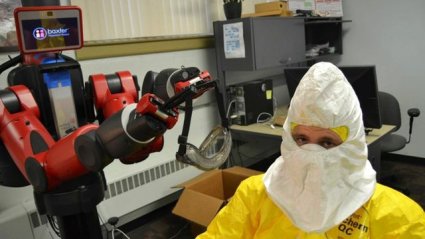
Robohub.org
Who will buy your bot? End user opportunities
 Unless robotics is just a hobby, commercial and funding opportunities should be at the forefront of every developer’s mind and at the root of these are the end users and their needs. But who are the end users in robotics? Here, we profile three industries – nuclear, transport and healthcare – where the need for robotic and autonomous systems is emerging as a priority.
Unless robotics is just a hobby, commercial and funding opportunities should be at the forefront of every developer’s mind and at the root of these are the end users and their needs. But who are the end users in robotics? Here, we profile three industries – nuclear, transport and healthcare – where the need for robotic and autonomous systems is emerging as a priority.
Nuclear decommissioning
Decommissioning nuclear sites may not at first glance have a great deal to do with dirty dishes, but add a robot called Boris – which started life perfecting its dexterity through loading dishwashers, and is now to begin trialling at Sellafield – and it all begins to make sense.

Decommissioning of a nuclear plant, the containment is shown in the picture and is half deconstructed. Source: National Regulatory Commission.
A product of the Intelligent Robotics Laboratory at the UK University of Birmingham, Boris is one of the first robots in the world capable of intelligently manipulating unfamiliar objects with a humanlike grasp. His skills were first demonstrated in a dishwasher loading task that hit headlines worldwide.
Team member Krzysztof Walas explained that Boris’s new Sellafield role is less of a promotion and more of a progression.
“The first project was on grasping, the follow up was on dishwasher loading – those projects were FP7 [EU Funding Programme Seven}. Now [we’re working on] a Horizon 2020 project on nuclear waste decommissioning, which is in collaboration with nuclear waste companies and laboratories across Europe.”
Collaborations such as the one between the Intelligent Robotics Laboratory and nuclear waste companies are a major source of growth for robotics and autonomous systems (RAS), according to RAS Special Interest Group Chair, David Lane.
“RAS has a role to play in decommissioning, re-commissioning and long-term waste management, with positive implications for both safety and cost,” he beleives. “The total cost of nuclear decommissioning in the UK alone, mostly at Sellafield, is currently estimated at £60 billion. Owing to the high levels of radiation, all stages of the nuclear fission and fusion life cycle will require the use of advanced RAS tools and techniques.”
Sellafield is working with a number of small businesses – including snake robot arm developers, OC Robotics – to develop these tools. Sellafiled is investing over £70m per annum on R&D to deploy new technologies that reduce the risks and costs associated with nuclear waste. It’s an investment likely to increase year on year as the decommissioning objective becomes an imperative.
Find out more about collaboration opportunities in nuclear decommissioning via the NDA website.
Transporting London
Providing smooth and reliable transport for London’s burgeoning population is already a challenge, but what will happen when another million people enter the equation? This is the challenge faced by John Downes, Head of Engineering Governance & Services at London Underground. Transport for London (TfL), which oversees the Underground, is on the hunt for innovative proposals to help solve the capital transport conundrums.
“The challenge is moving towards London,” Downes told delegates at last month’s RAS in Horizon 2020 event. “London will have one million additional inhabitants by 2030, it’s as if the current population of Birmingham moved to the capital.” To deal with this population surge, the city has to have a very efficient network in palace and we must lever off the technology, he stressed.
To encourage companies to work with TfL, the organisation has established a Technology Innovation Portal allowing users to speedily input ideas and solutions that meet key challenges. These are grouped into six categories:
- Customer
- Value and sustainability
- People
- Delivery
- Reliability and dependability
- Safety
Each category has specific challenges such as: to deliver faster, more frequent services, improve energy efficiency and sustainability, increase workforce flexibility, improve safety and asset condition monitoring.
For a flavour of the improvements already in hand, earlier this year TFL released digitally simulated video of improvements to tube lines that are expected over the next decade.
 Designed by PriestmanGoode, The “New Tube for London” features a futuristic design that abandons the traditional multi-carriage layout for a walk-through car that will provide passengers with air-cooling and onboard Wi-Fi for the first time. TfL plans to deploy 250 of these next-generation tube trains on the Piccadilly, Bakerloo, Central and Waterloo & City Lines over the next decade.
Designed by PriestmanGoode, The “New Tube for London” features a futuristic design that abandons the traditional multi-carriage layout for a walk-through car that will provide passengers with air-cooling and onboard Wi-Fi for the first time. TfL plans to deploy 250 of these next-generation tube trains on the Piccadilly, Bakerloo, Central and Waterloo & City Lines over the next decade.
Although the new trains will be driver enabled, they are also designed to run automatically and intended to last for 30 years, running 24 hours a day. The new trains would boost capacity on the Piccadilly line alone by around 60%. That sounds a lot, but when 10 million extra people are factored in, it becomes obvious that simply improving train efficiency is not enough. That’s why your ideas are vital.
TfL’s Technology Innovation Portal is designed to act as a premier resource but you can also email Innovation.Office@tfl.gov.uk with your query.
Robotics in healthcare
Developed by US company Rethink Robotics as a highly adaptable tool in manufacturing, Baxter is not the first automaton that comes to mind when considering the needs of the healthcare industry. But the news last week of Rapid Response Research awards for researchers working with Baxter on a human-robot system for removing the necessary protective clothing that workers caring for patients with Ebola require, shows how varied the opportunities in this space can be.
“The challenges in the field are so varied, you need to think laterally,” counselled Small Business Research Initiative (SBRI) Director Karen Livingstone, who is also Head of Partnerships and Industry at the Eastern Academic Health Science Network. She was speaking to delegates at an event centred on the latest Horizon 2020 funding call at the end of last year, and wished to draw attention to the myriad possibilities available in healthcare.“ The fact that it may not be a natural space for robotics doesn’t mean it’s not a good opportunity,” she said.

Researchers are trying to prove Baxter could be used to dispose of contaminated clothes. Source: BBC News
An NHS England initiative, SBRI healthcare is championed by the UK’s Academic Health Science Networks. The aim is to promote economic growth whilst addressing unmet health needs. SBRI gives SMEs an opportunity to connect with public sector procurement by inviting them to present innovative solutions to specific problems in a competition format. Winning proposals can result in 100 percent funded government development contracts.
So what is the healthcare industry looking for from robotic and autonomous technologies? Challenges highlighted by Livingstone in her presentation include self care, management of care, remote monitoring, data management, wound management and diagnosing on the spot. Outlining the support that SBRI healthcare can offer business initiatives she said:
“Clinicians working together with entrepreneurs and technology specialists gives us an exciting mix that leads to real innovation.”
“The NHS has many challenges to tackle. Through the SBRI healthcare programme, we are building long-term partnerships with industry to create new products that will save lives and deliver economic value to the UK economy.”
Traditionally, robots have played a key role in the manufacturing sector, but with advances in what’s known as social robotics they could also play a fundamental part in improving quality of life, particularly in the home and non-industrial environments. And healthcare is one area where there is a lot of interest. The technology can greatly help surgical procedures, as seen with the Da Vinci Robot, and there have been moves into the bionics space with prosthetics and rebuilding damaged limbs.
A big attraction is socially assistive robots in healthcare and Baxter’s new role is a good example. Others include Aldebaran’s Nao, which has been successful with autistic children in helping to develop communication and social skills and the Japanese-invented PARO-Seal robot is being used with NHS dementia patients.
In fact, the realm of the healthbot could include anything from monitoring patients’ movements to assisting with care tasks, although that’s not tot say that there aren’t substantial challenges specific to this sector.
Focusing on technological innovation but with a strong emphasis on clinical translation and direct patient benefit, the UK’s Hamlyn Centre is at the forefront of research in imaging, sensing and robotics for addressing global health challenges.
The centre hosts outreach activities, and is active in its support for the healthcare business and the training of surgeons and engineers in robotic technologies, It also aims to overcome global health challenges by harnessing Imperial’s interdisciplinary research strengths and its expertise in safe, effective and accessible technologies. At the Horizon 2020 event, a demonstration of the centre’s research by its Director, Professor Yang, (pictured above with Minister of State for Universities, Science and Cities, Greg Clark) provoked much interest.
Markets and Markets research predict that the medical robotics market will grow to $3,764m by 2018. With the necessity of major changes in the way healthcare is delivered, there’s never been a better time for developers working in robotics and automation to present solutions.
This article was originally published on RAS SIG – the Robotics and Autonomous Systems Special Interest Group, part of Innovate UK’s Knowledge Transfer Network.
If you liked this article, you may also be interested in:
- Dmitry Grishin on evaluating robotic investment opportunities
- Loving your #startup to death
- Guiding technology through uncertain valleys: SRI’s Rich Mahoney on risks, rewards, and the future of robotics
- Why fostering high-tech innovation and entrepreneurship matters to the economy, and what universities can do about it
See all the latest robotics news on Robohub, or sign up for our weekly newsletter.
tags: c-Research-Innovation, cx-Business-Finance, startups




